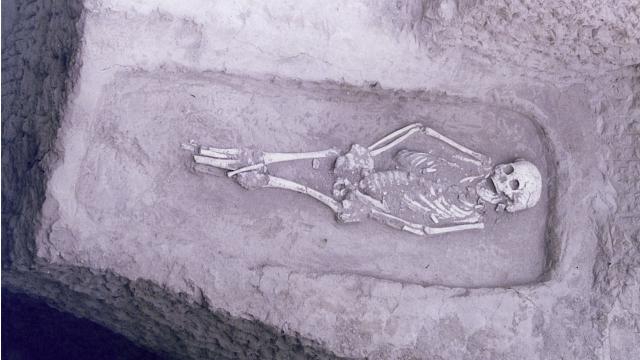The discovery of a 5,000-year-old skeleton of a young adult who had serious physical limitations suggests a form of social support existed in Neolithic China, but only to a point, as this individual may have met an untimely death.
The skeleton was found at the Guanjia site in China’s Henan Province, and it dates back to the late Neolithic Yangshao cultural period (3300–2900 BCE). A recent analysis of this skeleton has revealed an array of physical and possibly cognitive health issues that would have required others to take care of this individual, according to new research published in the International Journal of Paleopathology.
Designated M53, this person had normal body proportions but was far shorter than typical, with a slender build. The researchers, a collaborative team from Queens College in New York, the University of Otago in New Zealand, and other institutions, were unable to determine the individual’s sex, but the person died after reaching adulthood. M53 was buried according to normal Yangshao customs, but their hands were positioned behind their back, for reasons that aren’t clear. Analysis of the skeleton also revealed neck fractures, which likely contributed to M53’s death—injuries that were possibly inflicted intentionally.
Importantly, M53 had bones that were very thin and hollow, similar to severe osteoporosis, and they likely had very weak muscles, as evidenced by specific skeletal muscle markings. Taken together, this suggests M53 had physical dysplasia, leading to a kind of dwarfism, an underdeveloped body, and a feebleness. This individual would’ve been very physically limited and possibly even paralysed. What’s more, if M53 was affected by severe hormonal problems—which appears to be the case—they may have also experienced cognitive delays and mood disorders, according to the new research.
Ekaterina Pechenkina, a co-author of the study and an anthropologist at Queens College, said these anomalous traits may have been caused by a reduced function of the pituitary gland, a critical gland that “regulates our growth and general well-being,” she explained in an email to Gizmodo. “Among other things, it produces the growth hormone.” Indeed, her team’s analysis of the skull revealed depressions in a bony structure that hosts the pituitary gland—a sign that a tumour had caused the gland to stop working properly.
Pechenkina said “all these skeletal manifestations suggest hypopituitarism as a diagnosis,” a rare condition in which the pituitary gland can’t produce sufficient hormones, leading to a host of problems, including muscle weakness. Consequently, this rare find is offering new insights into the cultural norms of the period and how individuals with noticeable physical differences or disabilities were treated.
“We know that M53 was a tiny individual with very slender, fragile bones and underdeveloped muscles, who despite their limited physical abilities survived into adulthood,” said Pechenkina.
Survival in this 5,000-year-old northern Chinese farming community would’ve required considerable physical strength, Pechenkina explained. Chopping wood to build fires during the cold winters would’ve been an “essential” skill, she said. To acquire food, people needed to turn soil, plant seeds, water crops, and so on.
“I think that a slender and a fragile individual, such as M53, needed lots of support and help from their family members,” said Pechenkina. “It is unlikely that they were ostracised by their community,” she said, as there was no evidence of abuse or signs of old fractures. And because M53 was buried in a (reasonably) typical way, they were “regarded as one of their own,” she said.
The exact “model of care,” in the words of the researchers, is unknown, but Sian Halcrow, a co-author of the study and a researcher at the University of Otago, said it very likely existed in some form.
“That’s because the dysplasia likely had some associated health effects from an early age, and that would have meant M53 would have had extra care needs,” said Halcrow in a press release. “But they lived into adulthood so it’s likely they were the recipient of care from other members in their family or wider society.”
That said, Pechenkina and her colleagues believe M53 likely died from the aforementioned neck fracture.
“Their neck vertebrae appear to be fractured around the time of death, which makes it likely that eventually they were killed by their group members, either because they became to be seen as a burden or because their health deteriorated or, perhaps, because their caretakers became too old or died,” said Pechenkina. “For me, an interesting question is whether our M53 individual was recognised as different from an early childhood or only after a certain age when their short stature and fragility became apparent,” she said, adding that, “I suspect that up until a certain age they were likely cared for as a child.”
The troublesome circumstances of M53’s death notwithstanding, their survival into adulthood would have required lots of time, patience, and resources—and also a certain degree of compassion and acceptance. Yes, the Neolithic was tough, but it was clearly far from barbaric.
[referenced url=” thumb=” title=” excerpt=”]
No doubt, this discovery shows one way in which Neolithic culture was socially advanced, but we shouldn’t be too surprised (evidence from earlier this year revealed that Neolithic European babies drank animal milk from sippy cups, as just one example). Evidence of social support goes back even further in time—as far back as the Neanderthals and other archaic humans, who cared for severely physically disabled members of their communities. Prosocial behaviours such as these, it might be argued, contributed greatly to the success of our species.
